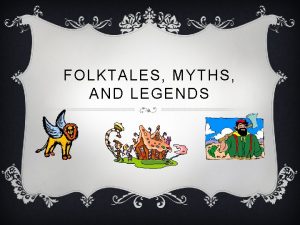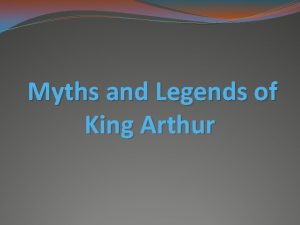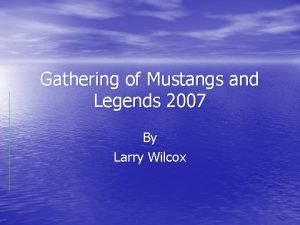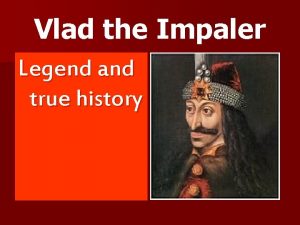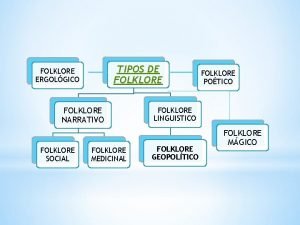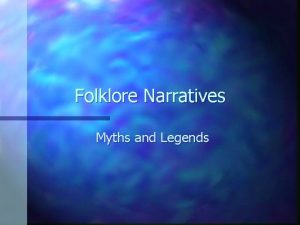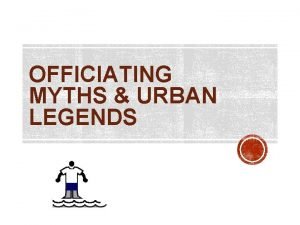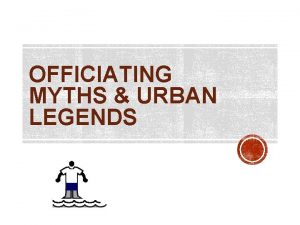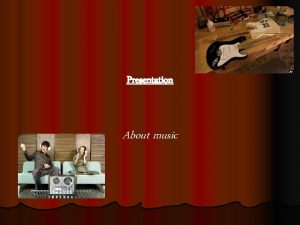What is Folklore Folklore consists of legends music










- Slides: 10

What is Folklore? Folklore consists of legends, music, oral history, proberbs, jokes, popular beliefs, fairy tales, stories, tall tales, and customs that are the traditions of a culture. CULTURE - Folklore - Carmen del Moral 1

English folklore is the folk tradition which has developed in England over a number of centuries. Some stories can be traced back to their roots, while the origin of others is uncertain or disputed. England abounds with folklore, in all forms, from such obvious manifestations as the traditional Robin Hood tales, the Arthurian legend, the poetry tale of Beowulf, to contemporary urban legends such as the Beast of Bodmin Moor. English folklore is largely drawn from Germanic, Celtic and Christian sources. CULTURE - Folklore - Carmen del Moral 2

What are folktales? In short, a folktale is a popular short sory passed on in spoken form from one generation to the next. We usually don´t know its author and there are many versions of it. The same story may also appear in different cultures. Folktales comprise fables, fairy tales and, even, urban legends. CULTURE - Folklore - Carmen del Moral 3

And fairy tales ? A fairy tale is a type of short story that typically features folkloric fantasy characters, such as fairies, goblins, elves, trolls, dwarves, giants, mermaids, or gnomes, and usually magic or enchantments. CULTURE - Folklore - Carmen del Moral 4

Like all folktales they are narratives that are not believed to be true , often in timeless settings (once upon a time) in generic, unspecified places (the woods), with one-dimensional characters (completely good or bad). They function to entertain, inspire, and enlighten us. They sometimes have a moral or a warning. In these episodic narratives the main characters are usually humans who often follow a typical pattern (as in a heroic quest) that is resolved partly by magic. http: //www. littleredridinghood. ca/? s=6 efe 0 b 895060 a 27 b 545 ae CULTURE - Folklore - Carmen del Moral 5

The characters and motifs of fairy tales are simple and archetypal: princesses, youngest sons and gallant princes; ogres, ˈəʊɡər / giants, ˈdʒaɪənt/ dragons, and trolls; wicked stepmothers; fairy godmothers and other magical helpers, often talking animals; prohibitions and breaking of prohibitions, curses and spells. CULTURE - Folklore - Carmen del Moral 6

They take place once upon a time rather than in actual times They have existed for thousands of years, although not perhaps recognized as a genre; Many of today's fairy tales have evolved from centuries-old stories that have appeared, with variations, in multiple cultures around the world. Fairy tales, and works derived from fairy tales, are still written today. CULTURE - Folklore - Carmen del Moral 7

The older fairy tales were intended for an audience of adults, as well as children, they were associated with children later; the Brothers Grimm titled their collection Children´s and Household Tales, and the link with children has only grown stronger with time. The oral tradition of the fairy tale came long before the written page. Tales were told or enacted dramatically, rather than written down, and handed down from generation to generation. CULTURE - Folklore - Carmen del Moral 8

The fairy tale itself became popular among upper-class in France (1690– 1710), and among the tales told in that time were the ones of La Fontaine and the Contes of Charles Perrault (1697), whose collections contain the oldest known forms of various fairy tales. The Brothers Grimm compiled several tales for their collection, told orally to them by Germans, because the tales derived from Perrault. The fairy tales of a country were particularly representative of it. Although, fairy tales with very similar plots, characters, and motifs are found spread across many different cultures. CULTURE - Folklore - Carmen del Moral 9

Analyze the main characters in tales: u The hero & heroine (prince & princess) Characteristics (What are their virtues? : kindness? Generosity? . . ) How the female role has evolved (compare Snow-White & Mulán) u The villain (the witch, stepmother, etc) Characteristics (What are their sins? : envy? greed? Wickedness? . . . ) CULTURE - Folklore - Carmen del Moral 10
 Online music portfolio
Online music portfolio Music that employs electronic musical instruments
Music that employs electronic musical instruments Classification of pamulinawen
Classification of pamulinawen Very romantic music
Very romantic music Is organized into recognizable/recurring accent patterns
Is organized into recognizable/recurring accent patterns British easter customs
British easter customs What is folklore in literature
What is folklore in literature Myths and legends of king arthur
Myths and legends of king arthur Legends moonshine
Legends moonshine Gathering of mustangs and legends
Gathering of mustangs and legends Tepes family
Tepes family






